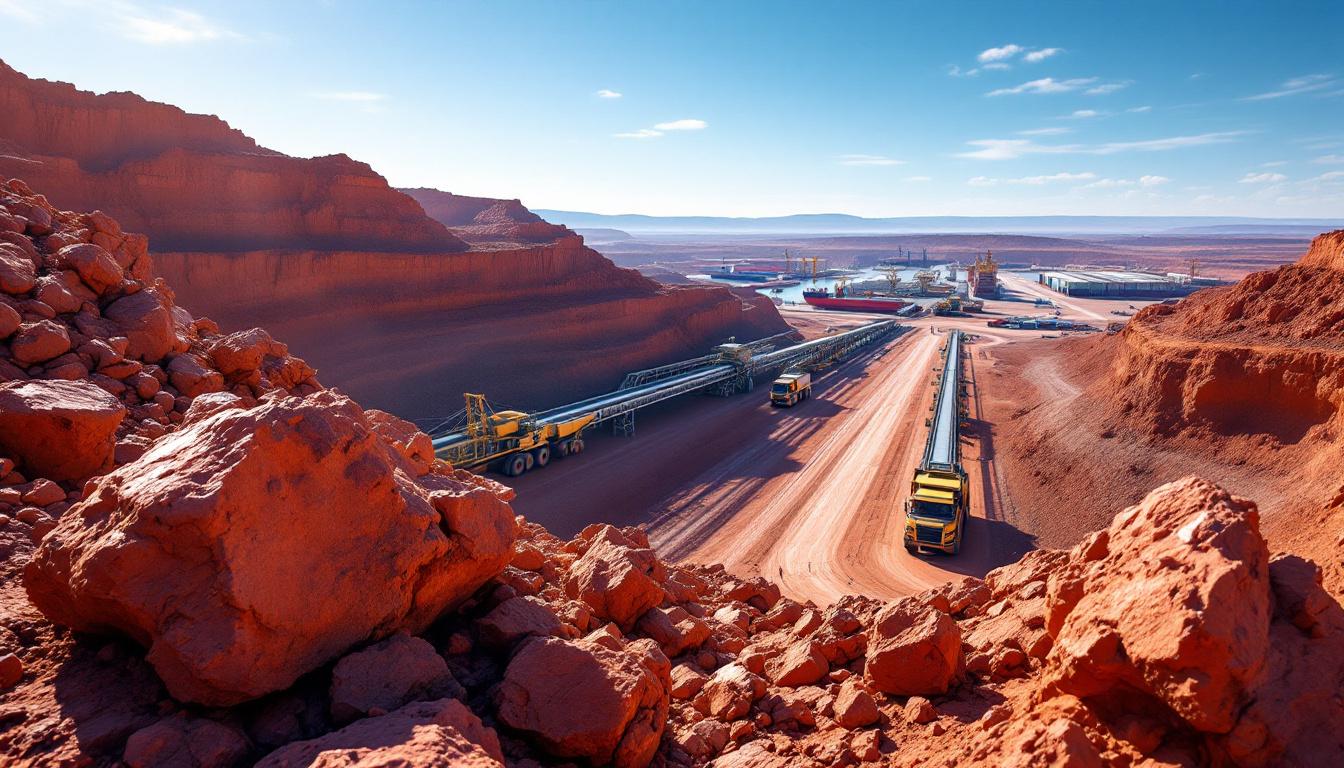How Is China Controlling the Rare Earths Market?
China has maintained dominance in the rare earths market for decades, controlling approximately 60% of global rare earths processing capabilities despite holding only 38% of global reserves. The United States refines about 15% of supply, while Australia processes around 8% of global rare earths supplies. China has long recognized the strategic importance of rare earths and has leveraged its dominant position for political advantage.
China implemented export restrictions in April 2025 in response to U.S. tariffs, creating significant market disruption and price volatility. These restrictions are part of a series of increasingly stringent curbs on critical minerals exports from China, forcing consumers to look elsewhere for these essential materials.
"China has long identified the strategic significance of rare earths and used its dominance as political leverage," notes an industry analysis from the Motley Fool Australia.
China's Market Dominance by the Numbers
- China controls 38% of global rare earths reserves
- China processes 60% of global rare earths supply
- Vietnam holds 19% of global reserves
- Brazil accounts for 18% of global reserves
- Russia possesses 10% of global reserves
- Rest of the world holds approximately 15% of reserves
The U.S. Geological Survey highlights that China's decades-long investment in refining technology and relatively lax environmental regulations have been key drivers in establishing and maintaining this control.
Recent Restrictions and Political Leverage
China's rare earths processing involves sophisticated solvent extraction and ion-exchange techniques, which are capital-intensive and technically complex. This vertical integration from mining to magnet production creates a near-monopoly on downstream applications that has proven difficult to replicate elsewhere.
A 2023 EU Report revealed that China supplied 98% of Europe's rare earth magnets, which are critical components for electric vehicles. Similarly, in 2025, the U.S. Defense Department cited significant reliance on Chinese dysprosium for missile guidance systems, highlighting the strategic vulnerabilities created by China's Export Restrictions Impact.
Why Are Rare Earths So Important?
Despite their name, rare earth elements are relatively abundant in the Earth's crust. However, they are critical ingredients in manufacturing countless electronic and defense technologies. Their unique properties make them virtually irreplaceable in many high-tech applications.
Neodymium and praseodymium (NdPr) comprise 85% of EV motor magnets, while dysprosium improves magnet heat resistance—a critical property for wind turbines used in 90% of offshore projects.
"Rare earths are the 'vitamins' of modern tech—without them, everything from iPhones to F-35s stops," according to the MIT Technology Review.
Applications of Rare Earth Elements
- Smartphones and mobile devices (terbium for displays, neodymium for speakers)
- Computer screens and displays (europium for color enhancement)
- Electric vehicle motors and batteries (Tesla's 2025 Model Z requires 12 kg of rare earths per vehicle, doubling 2020 levels)
- Wind turbines (heavy rare earths improve magnet performance at high temperatures)
- Defense systems and military equipment (U.S. Patriot Missiles use samarium-cobalt magnets for radar systems)
- Medical imaging equipment (gadolinium for MRI contrast agents)
- Catalytic converters (cerium as an oxidation catalyst)
Demand for rare earth elements is projected to grow at approximately 8% CAGR between 2025 and 2030, primarily driven by the clean energy transition and defense sector expansion.
Key Rare Earth Elements
- Yttrium: stabilizes camera lenses and is critical for LED lighting
- Dysprosium: improves magnet performance at high temperatures
- Terbium: enables color screens in smartphones and is essential for solid-state hard drives
- Gallium: critical for 5G infrastructure and semiconductor manufacturing
- Germanium: used in fiber-optic cables and solar panel technology
The substitution of these elements has proven extremely challenging. Toyota's 2024 attempts to replace neodymium in motor magnets resulted in significant performance losses, reinforcing the essential nature of these materials.
How Are ASX Rare Earths Shares Performing?
Australian Securities Exchange (ASX) listed rare earths companies have seen significant share price movements in response to what China's rare earths ban means for these ASX shares, presenting both opportunities and risks for investors.
Lynas Rare Earths Ltd (ASX: LYC)
- Market capitalization: approximately $7.5 billion
- Share price increase: 30% since late January 2025
- Current share price: around $8 (up from $6.16 in January)
- Position in market: "The world's only significant producer of separated rare earth materials outside of China"
"Lynas is the only non-Chinese producer capable of full separation," stated CEO Amanda Lacaze during a 2025 investor call, highlighting the company's unique position in the global market.
Lynas' Mt Weld mine holds 1.8 million tons of rare earth oxides, with a 40-year reserve life, providing long-term supply security. The company's 2024 joint venture with the U.S. Department of Defense to build a $300 million Texas processing plant further strengthens its strategic position.
With an EV/EBITDA ratio of approximately 15x, Lynas trades at a premium to global peers like MP Materials (12x), reflecting the geopolitical risk premium investors are willing to pay for non-Chinese supply.
Arafura Rare Earths Ltd (ASX: ARU)
- Share price increase: approximately 70% since January 2025
- Current share price: around 19 cents
- Historical context: Down from 60 cents in 2023 (68% below previous highs)
Arafura's Nolans Rare Earths Project aims to produce 4,400 tons per year of NdPr by 2027, positioning the company as a future significant supplier to non-Chinese markets. However, the company experienced a 70% share price drop between 2023 and 2024, primarily linked to delayed offtake agreements and financing challenges.
What Are the Risks of Investing in Rare Earths?
The ASX rare earths space offers potential for rapid gains but comes with significant volatility and risk that investors must carefully consider when exploring investing in mining stocks.
Volatility Factors
- Lynas shares have gained 30% in recent months but remain below yearly highs
- Arafura shareholders who bought at 11 cents have seen significant gains
- Those who bought Arafura at 60 cents in 2023 are facing substantial losses
- Geopolitical tensions directly impact market performance
- Supply chain disruptions can cause rapid price fluctuations
Lynas shares demonstrate approximately 22% volatility versus the ASX 200's 10% (2025 Beta), indicating the sector's heightened risk profile. Processing costs outside China are typically 30% higher due to more stringent environmental compliance requirements, creating margin pressure.
"One policy shift in Beijing can wipe out margins for junior miners," warned Goldman Sachs in their 2025 Resources Report, highlighting the precarious position of smaller players.
Strategic Considerations
- China's export restrictions create opportunities for non-Chinese producers
- Growing global demand for electronics and green technology supports long-term growth
- Political uncertainty affects market stability
- Processing capacity outside China remains limited
The sector has witnessed extreme price volatility, with NdPr oxides fluctuating from $50/kg in 2023 to $120/kg in 2025. Supply chain bottlenecks remain significant, with permitting timelines for non-Chinese mines averaging 7 years from discovery to production.
Molycorp's 2015 bankruptcy following Chinese price manipulation serves as a cautionary tale for investors. Similarly, the 2024 EU Critical Raw Materials Act failed to significantly reduce European reliance on Chinese imports, demonstrating the challenges of reshoring supply chains.
How Might the Rare Earths Market Evolve?
As China restricts access to processed rare earths, consumers must diversify their supply chains, potentially benefiting ASX-listed producers over the long term.
Future Market Dynamics
- Increasing investment in processing capacity outside China ($2 billion invested in U.S. facilities since 2024)
- Growing strategic importance of rare earths in national security contexts
- Potential for price premiums for non-Chinese rare earths
- Development of recycling technologies to reduce dependency on mining
"The West's $50 billion push for self-sufficiency will reshape trade flows," according to BloombergNEF's 2025 analysis, suggesting structural changes to the market are underway.
Recycling shows significant promise, with the potential to recover 20% of global e-waste to meet 15% of demand by 2030. Advanced hydrometallurgical recycling processes can recover up to 95% of rare earths from magnets, creating a circular economy opportunity.
Apple's 2025 commitment to use 100% recycled rare earths in iPhones signals growing corporate interest in sustainable sourcing. Meanwhile, the Australia-India joint venture to build a $1.1 billion refinery in Tamil Nadu illustrates the geopolitical realignment of supply chains.
Industry projections indicate a potential NdPr supply gap of 50,000 tons by 2030 if electric vehicle adoption accelerates at forecast rates. This supply shortage could support higher prices for producers outside China's sphere of influence, according to a recent Stockhead analysis.
FAQ: Rare Earths Investment Questions
What exactly are rare earth elements?
Rare earth elements are a group of 17 metallic elements that, despite their name, are relatively abundant in the Earth's crust. They include elements like neodymium, praseodymium, dysprosium, and terbium, which are crucial for manufacturing high-tech products including smartphones, electric vehicles, wind turbines, and military equipment.
These elements' unique magnetic, luminescent, and electrical properties make them indispensable for modern technology. Despite being classified together, each element has specific applications: neodymium creates powerful permanent magnets, europium produces red color in displays, and terbium enables touchscreen functionality.
Why does China dominate the rare earths market?
China's dominance stems from decades of strategic investment in mining and processing capabilities, lax environmental regulations that kept costs low, and government policies that prioritized the sector. While China holds 38% of global reserves, it controls approximately 60% of processing capacity, giving it significant market power.
This dominance didn't happen by accident. China began investing in rare earths development in the 1980s when other countries viewed the sector as unprofitable. By accepting the environmental impact of processing (which includes radioactive waste management), China established a competitive advantage that proved difficult to overcome.
How might China's export restrictions affect global supply chains?
China's restrictions could cause short-term supply disruptions and price increases for rare earth elements. This may accelerate efforts by other countries to develop alternative supply chains, benefiting companies like Lynas that operate outside China. Long-term effects could include increased investment in rare earths projects globally and the development of recycling technologies.
Companies with established supply chains outside China will likely command premium prices for their products, particularly in defense applications where supply security is paramount. Vietnam's 2025 policy to ban raw exports, forcing onshore processing, represents another significant shift in the global market structure that could further fragment supply chains.
Conclusion
China's rare earths strategy underscores asymmetric interdependence, with ASX miners positioned to capitalize on Western reshoring initiatives. However, investors must navigate technical complexity, policy uncertainty, and relentless volatility in this space.
Lynas' established scale and Arafura's promising project pipeline offer exposure to the sector's growth potential, but diversification into recycling technologies (such as Renascor Resources) may help mitigate risk. The most successful investment strategies will likely balance pure-play producers with companies developing alternative technologies and recycling solutions.
For investors considering this sector, monitoring Q3 2025 U.S. Defense Production Act allocations and Vietnam's export policy shifts will provide critical insight into future mining trends 2025. The critical minerals race represents both strategic opportunity and substantial risk—requiring careful analysis beyond typical commodity investment frameworks.
Looking to Get Ahead of the Next Major Mineral Discovery?
Discovery Alert's proprietary Discovery IQ model provides instant notifications when significant mineral discoveries are announced on the ASX, giving you a crucial edge in identifying potential investment opportunities like the rare earths producers discussed above. Explore historic returns from major discoveries and how they can transform portfolios by visiting the dedicated discoveries page.




